Do you use embroidery kits? The answer to this question seems to divide embroiderers into different groupings: 1. The no-never types; 2. The yes-always types; 3. The yes-but-only-selectively types. Within these categories, there are different mentalities about kits. There are, for example, the no-nevers-on-principle, who believe that kits stunt the creative process. Then there are the no-nevers-on-opportunity, who don’t want to pay for kits. Then there are the no-nevers-whatsakit?, who have really never considered kits, and don’t care either way about them. And the list could go on….
I belong to the 3rd category – yes, but selectively.
I have a couple embroidery kits on hand that I want to work, and I’ll show some of them to you here.

My favorite kits so far in my needlework life have been Tanja Berlin’s needlepainting kits. Through them, I’ve learned a lot about needlepainting! I haven’t worked a kit in ages, but I’ve got a few of hers in my stash, awaiting the day, specifically the squirrel and a bird or two…
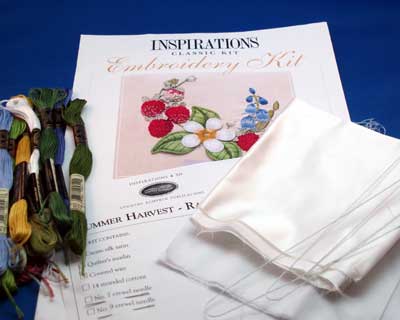
Country Bumpkin needlework kits are also among my favorites. One of my Christmas gifts this year was an order from Country Bumpkin, and included in that were two kits: a little “Summer Harvest” stumpwork kit and a needlepainting kit called “True Love” that I find downright hilarious and that I’m planning to use as a future wedding gift.
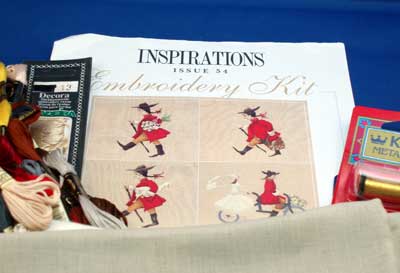
The differences between Tanja Berlin’s kits and Country Bumpkin’s kits are notable. I thought I’d point some of the differences out to you, in case you’re looking for a new project to work or a new technique to learn and are thinking about starting with a kit.
Country Bumpkin Needlework Kits:
1. Country Bumpkin relies upon your owning the magazine in which the project is featured. Kits are an off-shoot of their magazine, Inspirations. The purpose of CB kits is simply convenience: the kit includes all the supplies you need to complete a project featured in one of their magazines, but it doesn’t include the design or the instructions. It is simply a materials kit. If you don’t subscribe to the magazine, you have the option, when you purchase the kit, of purchasing the copy that coincides with the kit. The articles in the magazine have very detailed stitch instructions, diagrams, up-close pictures, and so forth. Each magazine has many beautiful projects in it, so when you buy one magazine, you’re actually getting excellent instruction on many projects, not to mention all the other interesting stitching tidbits and stories. It’s a great magazine!
2. The kits (in my experience) always have PLENTY of fibers to work the project. I’ve never felt as if I would run out of the required thread. Whole skeins and spools of most threads are included, rather than partial skeins or bits of threads. Also, any notions required in the project are also included (buttons and so forth), as well as supplies such as interfacing, wire, etc. In short, all materials! (Note: some blanket kits do not include the fabric backing; this is always noted in the kit contents.)
3. The design is not transferred onto the ground fabric. This is something you have to do, using the design in the magazine. I was a little surprised by this at first, because when I am working from a kit, I do like to launch right in (and forego the pre-work of transferring, which is not my favorite part of a project!). However, it makes sense. Country Bumpkin’s first focus is their magazine. If they sold kits with instructions and designs, it would be somewhat of a conflict of interest! On the bright side, if you are out to really learn embroidery, then knowing the ins and outs of transferring designs is an essential part of the process, so it’s good for the learning curve!
4. Country Bumpkin kits ship from Australia. For those of us in the States, anything we save in exchange rates is definitely eaten up in shipping. In this regard, the kits are somewhat expensive… and shipping tends to be a bit slow. But, if you want the kits, that’s part of the package!
Tanja Berlin’s kits:
1. Tanja’s kits come with everything you need to complete the project: instructions, design, colored photo of finished project, all diagrams, detailed stitching instructions and troubleshooting guide, all fibers, fabric, needles. She also has the option on her website of on-going consultation for stitchers working her kits, so if you run into a trouble spot, you can contact Tanja and she’ll help you through it.
2. Tanja’s kits contain just the amount of fibers you will need to complete the project, with a little leftover. So you don’t normally get full skeins of floss or spools of threads. She organizes the threads on a color card, with each color number marked clearly next to the thread.
3. In her surface embroidery kits, the designs are already transferred on the fabric for you.
4. Tanja is located in Canada. Depending on the exchange rate (which has fluctuated quite a bit in the last couple years), if you’re in the US, the kits may be slightly more expensive or slightly less expensive than the actual listing on her site. Shipping, too, is somewhat pricey, but she has lots of shipping options, so you can choose the least expensive one (though you’ll probably wait a little longer for your order). Tanja ships very quickly if she is not out of town teaching (she always leaves a notice on her website if she is out of town, and tells you exactly when she’ll be back…)
So those are the two kinds of kits that I have primarily indulged in over the years.
Other Types of Embroidery Kits
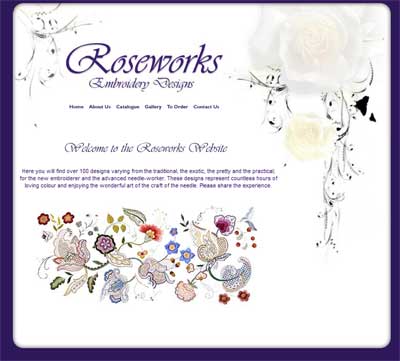
I’ve also worked kits from Roseworks Designs. They’re located in South Africa, and have some pretty kits available through retailers or ordered directly through Roseworks Designs. Their kits include fabric with the design on it, detailed stitching instructions, and a color key for Anchor and DMC colors, but they don’t always include the threads. These kits were more widely available in the US, but now I can only find one online retail shop that sells them here. The other shops I knew of that sold them have since gone out of business.
Another type of kit that I’ve purchased but haven’t worked is an Anchor Fleur de Lys teacloth. Margaret Cobleigh, however, persevered through the finish of the same kit, and graciously wrote up a whole document on how she altered the kit to make it more interesting. To see what these kits look like, you can check out her Spring Teacloth and her Strawberry Teacloth here on Needle’nThread. I have never quite gotten back to the Spring Teacloth. It has just never “grabbed” me, though I think Margaret did an absolutely stunning job on hers
!
Embroidery Kits I would Like to Work
Now, there are other kits offered out there that I’m interested in, but have not had the opportunity to try.
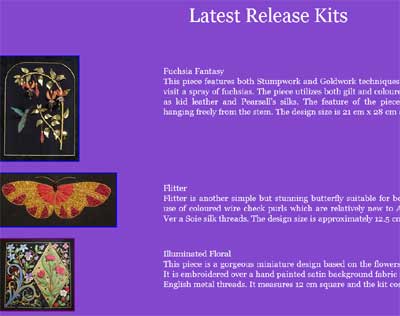
First, Alison Cole’s kits. One of these days, I may indulge in a couple of those, including her Illuminated Floral stumpwork and goldwork kit (which I’ve mentioned before) and some of her mini Or Nué kits (the frog, gecko, and strawberry, to be precise). Though I haven’t worked her kits, I assume they come with excellent instructions – her books are certainly excellent.
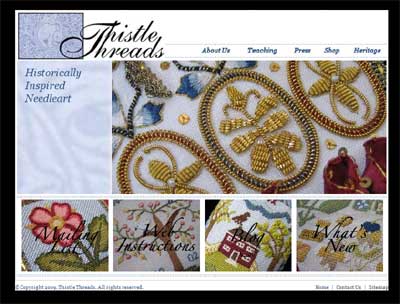
Then, there’s Tricia Wilson-Nguyen, the lady behind Thistle Threads, known for her expertise in historical needlework and her current work on the Plimoth Plantation 17th-century embroidered jacket. Did you know she offers kits? They’re mostly of an historical nature, and some are quite elaborate. Besides her exquisite licensed museum adaptations (part of the proceeds go towards the museums that host the original studied object), Tricia offers some limited edition kits that are neat, and many “regular” kits that are also enticing. The kits that I’m really interested in of hers are a bit out of my range, but it’s inspiring to look at them, nonetheless!
Trish Burr is also working on putting together some kits, and if and when that happens, those will definitely be something I’m interested in. Her books are greatly instructive, so I’m sure her kits will be, too.
My Embroidery Kit Philosophy is pretty much this: A kit can be an excellent way to learn or polish an embroidery technique. If the kit appeals to me in some way, I am not adverse to working a kit, and actually can find great pleasure and freedom in working one. I like buying kits from specific designers (as opposed to mass-produced commercial kits such as those found on the needlework aisles in chain stores). It’s a lot like making the effort to shop at a local needlework shop. Embroidery designers, writers, instructors, etc., keep the art of needlework alive – and many of them rely upon their designing and teaching for their livelihood. I don’t mind supporting that at all! (when I can afford to!)
That’s pretty much the way I look at kits. Do you like kits? Why or why not? Do you have favorite kit designers that you would recommend? In general, what are your experiences with kits? Please share!
Now, having said all that, I bet you think I’m heading off to get started on one of those kits. Nope – I’ve got “real” work (school work) to do all weekend long! No needlework for me this weekend (unless I can sneak in a wee session here and there when no one’s looking!)
Have a great weekend!







I like kits and I have stitched a LOT of them over the years. I do find that in the last few years the run-of-the-mill commercial kits no longer interest me, not to mention the fact that there are very few surface embroidery kits available. I really want to explore my own ideas and I’ve sort of imposed a moratorium on kits for myself.
However, if a really good one comes along I will break my ‘no kits’ rule. Tanja Berlin has a bunny design that is not yet ready for publication as a kit, but when it is I want to do that piece. (I also want to check out her instructions.)
I am also tempted by the same Alison Cole kit as Mary and so far I’ve been able to resist!
We won’t talk about the drawer-full of ‘Inspirations’ kits that I have waiting for me…sigh…and I have a few other commercial kits that I may or may not do. I like to keep them around in case I need something mindless to do.
One thing I miss about my kit days was how easy it was to just pick one out and start stitching. I also really like having the design pre-printed because that should be one of the advantages of a kit. The main reason I haven’t done my ‘Inspirations’ kits is because I don’t like transferring designs. (If I have to transfer a design I prefer to do my own and use a printer! 🙂
I don’t think anyone should feel bad about stitching a kit (and I hope no one does). In my opinion anything that gets someone to put needle and thread to fabric is OK by me.
I buy a kit if it will teach me a new skill or is such a good deal I can’t pass it up. For example, after this past Christmas I found a cross stitch kit for six 6″ inch stockings for only $3. The kit normally sells for $20. I couldn’t buy the materials for that price.
I have the advantage of being the manager in our store who does the price changes on products. I know when I go into work today I will be marking down some embroidery kits. One is for learning to stitch flowers and will be priced at 50 cents. I will pick one up just for the lesson.
I have a few of Tanja Belin’s kits and am looking forward to one by Trish burr. I did go on to the Roseworks site–WOW–definately gonna buy some!
Thanks for the tips
Ruth
Certainly I don’t feel bad about stitching a kit. Here stores have lots of cross-stitch and needlepoint kits I have to confess that it is not the kind of embroidery I LOVE (with capital letters).
But… (as you use to say)
you have been showing so many beautiful kits that I’m “adjusting my budget” (you have writte about some time ago)for some I have in my favourites 🙂
I have bought a few kits — not many — but their completeness is a definite advantage. I love Tanja’s kits — great instruction, generous materials, and the fact that they are already perfectly transferred onto the fabric. That is the biggest plus over the Inspirations kits, which I also like. As always, Mary, you tempt me to buy more and look at different designers!
Cissie
I’ve only ever done one kit (canvaswork tent stitch), but I plan to do another at some stage – I just love the idea of getting the package with all the supplies and being able to look at the pretty threads I’m going to use.
I actually have one of Tanja’s kits sitting in the online shopping cart in another tab on my browser. 🙂
I would absolutely love to pick up a few of Alison Cole’s kits but I’m not thrilled by the payment options available for US buyers. She does not accept international checks or online payment, which doesn’t leave you with much in the way of secure payment options.